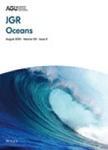版权所有:内蒙古大学图书馆 技术提供:维普资讯• 智图
内蒙古自治区呼和浩特市赛罕区大学西街235号 邮编: 010021

作者机构:Univ Delaware Sch Marine Sci & Policy Newark DE 19716 USA Univ Miami Rosenstiel Sch Marine & Atmospher Sci Cooperat Inst Marine & Atmosphere Studies 4600 Rickenbacker Causeway Miami FL 33149 USA
出 版 物:《JOURNAL OF GEOPHYSICAL RESEARCH-OCEANS》 (地球物理学研究杂志:海洋)
年 卷 期:2022年第127卷第7期
页 面:e2022JC018811-e2022JC018811页
核心收录:
学科分类:07[理学] 0707[理学-海洋科学] 0708[理学-地球物理学]
基 金:National Oceanic and Atmospheric Administration's (NOAA) Ocean Acidification Program (OAP) Cooperative Institute for Marine and Atmospheric Studies (CIMAS) Cooperative Institute of the University of Miami National Oceanic and Atmospheric Administration [NA20OAR4320472]
主 题:mid-Atlantic bight South Atlantic bight multiple linear regression model carbonate parameters coastal carbon system
摘 要:To overcome the limitations due to sporadic carbonate parameter data, this study developed and evaluated empirical multiple linear regression (MLR) models for dissolved inorganic carbon (DIC), pH in total scale (pH(T)), and aragonite carbonate saturation state (ohm(Ar)) using hydrographic data (temperature, salinity, and oxygen) measured during 2007-2018 in the South Atlantic Bight (SAB) and Mid-Atlantic Bight (MAB) along the U.S. East Coast. We first reviewed the assumptions and routines of MLR models and then generated MLR models for each cruise for all three carbonate parameters in each region and assessed model performance. Models derived from measured spectrophotometric pH have smaller uncertainties than pH(T) models based on pH calculated from total alkalinity (TA) and DIC. The regional differences of carbonate parameters between MAB and SAB are reflected in the coefficients of the empirical models. The MLR model temporal consistency indicates that the effect of the atmospheric CO2 increase on seawater carbonate parameters cannot be unequivocally resolved for the period of this study in the regions. Therefore, we combined different cruises to build composite models for each region. The composite models can capture the key features in the SAB and MAB. To further assess the model applicability, we applied our models to Biogeochemical-Argo data to reconstruct carbonate parameters. The algorithm in this study helps to reconstruct seawater carbonate chemistry using proxy data of high spatial and temporal resolution, which will enhance our understanding of physical and biological processes on carbon cycle and the long-term anthropogenic carbon inputs in coastal oceans.